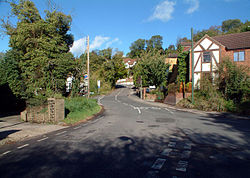Biggin Hill: Difference between revisions
Created page with '{{Infobox town |name=Biggin Hill |county=Kent |picture=Polesteeple Hill, Biggin Hill, Kent TN16 - geograph.org.uk - 67992.jpg |picture caption=Polesteeple Hill, Biggin Hill |os g…' |
No edit summary |
||
| Line 13: | Line 13: | ||
|constituency=Orpington | |constituency=Orpington | ||
}} | }} | ||
'''Biggin Hill''' is a town of [[Kent]], in the west of the county close to the | '''Biggin Hill''' is a town of [[Kent]], in the west of the county close to the border of [[Surrey]]. It is best known for Biggin Hill Airfield, one of the most important bases for the RAF during the Battle of Britain and whose role has continued since the war in more peaceful roles. | ||
Historically the village was known as Aperfield and formed part of the parish of [[Cudham]]. It took the name Biggin Hill after the Second World War in recognition of the historic role played by the adjoining Biggin Hill Aerodrome. | Historically the village was known as Aperfield and formed part of the parish of [[Cudham]]. It took the name Biggin Hill after the Second World War in recognition of the historic role played by the adjoining Biggin Hill Aerodrome. | ||
Latest revision as of 11:57, 3 December 2015
| Biggin Hill | |
| Kent | |
|---|---|
 Polesteeple Hill, Biggin Hill | |
| Location | |
| Grid reference: | TQ418590 |
| Location: | 51°18’46"N, -0°2’1"E |
| Data | |
| Post town: | Westerham |
| Postcode: | TN16 |
| Dialling code: | 01959 |
| Local Government | |
| Council: | Bromley |
| Parliamentary constituency: |
Orpington |
Biggin Hill is a town of Kent, in the west of the county close to the border of Surrey. It is best known for Biggin Hill Airfield, one of the most important bases for the RAF during the Battle of Britain and whose role has continued since the war in more peaceful roles.
Historically the village was known as Aperfield and formed part of the parish of Cudham. It took the name Biggin Hill after the Second World War in recognition of the historic role played by the adjoining Biggin Hill Aerodrome.
The most architecturally noteworthy building within Biggin Hill is St Mark's Church, Church Road - 'the moving church'.[1] - designed by Richard Gilbert Scott. It was erected in the 1950s using the dismantled materials from All Saints Church, North Peckham. Much of the work was undertaken by volunteers led by Rev Vivian Symons who undertook much of the decorative work himself.
Biggin Hill Airport
Biggin Hill Aerodrome as it was known during the War, is now labelled London Biggin Hill Airport.
RAF Biggin Hill Aerodrome hosted the "Operations Room" for the Operation Crossbow V-1 flying bomb defence during Second World War.
The old "west camp" of the airport is now owned by Bernie Ecclestone. Most of the buildings in the West Camp are Grade II listed. [2][3] A small section remains in the care of the RAF, and the Grade II listed chapel [4] (guarded by replicas of the base gate guardians, a Hawker Hurricane and a Supermarine Spitfire) is open to the public.
The old "south camp" is now occupied by the Biggin Hill Business Park, Airport Industrial Estate and various private flying clubs. There are further commercial premises, hangars, private flying clubs and a helicopter joy-ride and pilot training centre to the east of the main runway.
The term "airport", rather than airfield, is used to describe the present-day facility because it has a terminal building and customs facilities. It is host to a wide range of private/business jet and turbo-prop aircraft up to the size of a Boeing 737. The main airport apron has recently been enlarged; the one remaining hangar on the old south camp has been totally re-clad and a planning application has been posted for further hangars on the eastern side.
A model aircraft site operates within its Air Traffic Zone, operating large model aircraft. In 2009 there were sightings of model aircraft traffic and one air proximity report was filed, according to the Airport Consultative Committee in May 2010.[5]
Biggin Hill is the location of a VOR navigational beacon, codenamed "BIG", which anchors the South East Arrival Stack for Heathrow Airport.
The airport was the venue of the Biggin Hill International Air Fair, an annual airshow that usually took place towards the end of June. The event was first held in 1963 and the airshow was permanently cancelled in 2010, shortly after the 48th event.
Outside links
- Biggin Hill Local News, Information and Forum
- A brief commentary
- A comprehensive history
- Photographs
Aerodrome and air shows
- Biggin Hill weather, notams & pilot reviews on ukga.com
- The RAF Biggin Hill Mutiny of 1919 on peopleshistory.co.uk
- Biggin Hill Air Fair
- Illustrated Reviews:
- Biggin Hill air shows
References
- ↑ Symons, Vivian. The Moving Church. London: Herbert Jenkins.
- ↑ http://www.britishlistedbuildings.co.uk/en-495996-building-15-hawkinge-block-west-camp-bro
- ↑ http://www.britishlistedbuildings.co.uk/en-495982-buildings-1-to-5-airmens-barrack-blocks-
- ↑ http://www.britishlistedbuildings.co.uk/en-495981-memorial-chapel-bromley
- ↑ http://www.bigginhillairport.com/UserFiles/100520.ccminutes.pdf